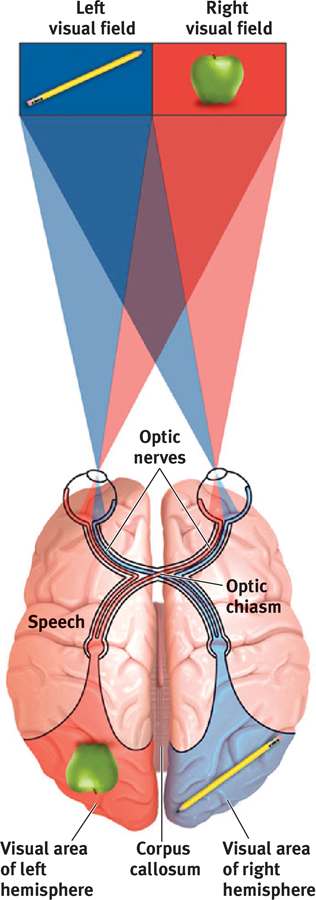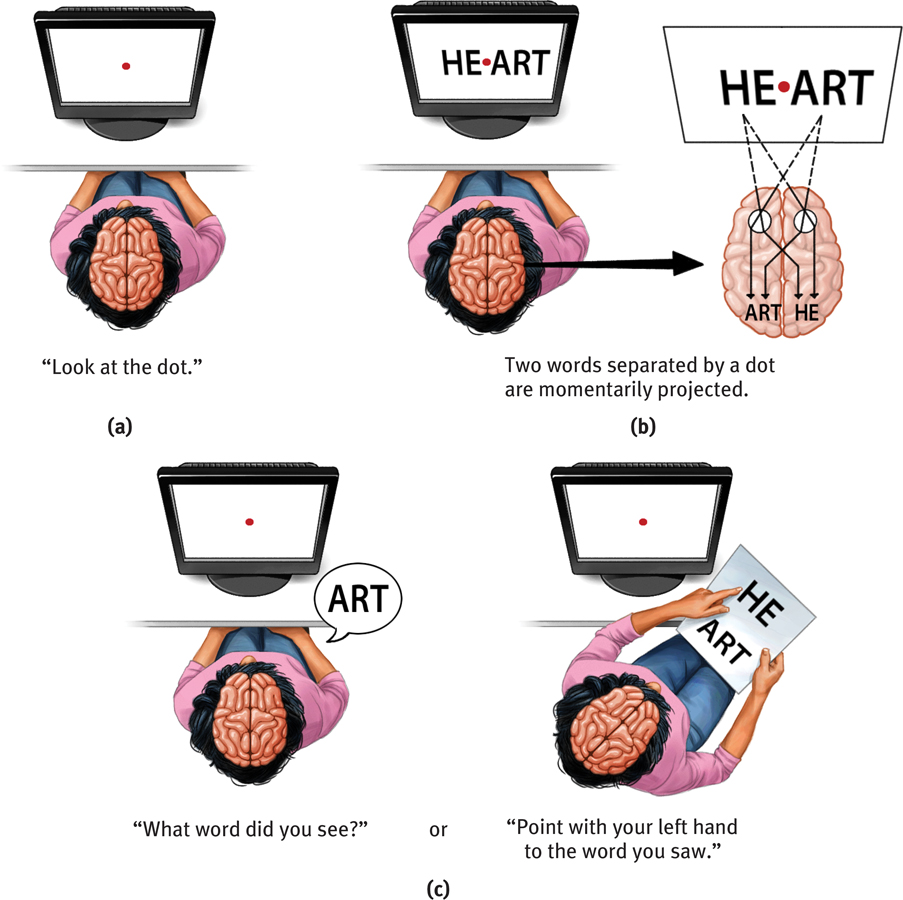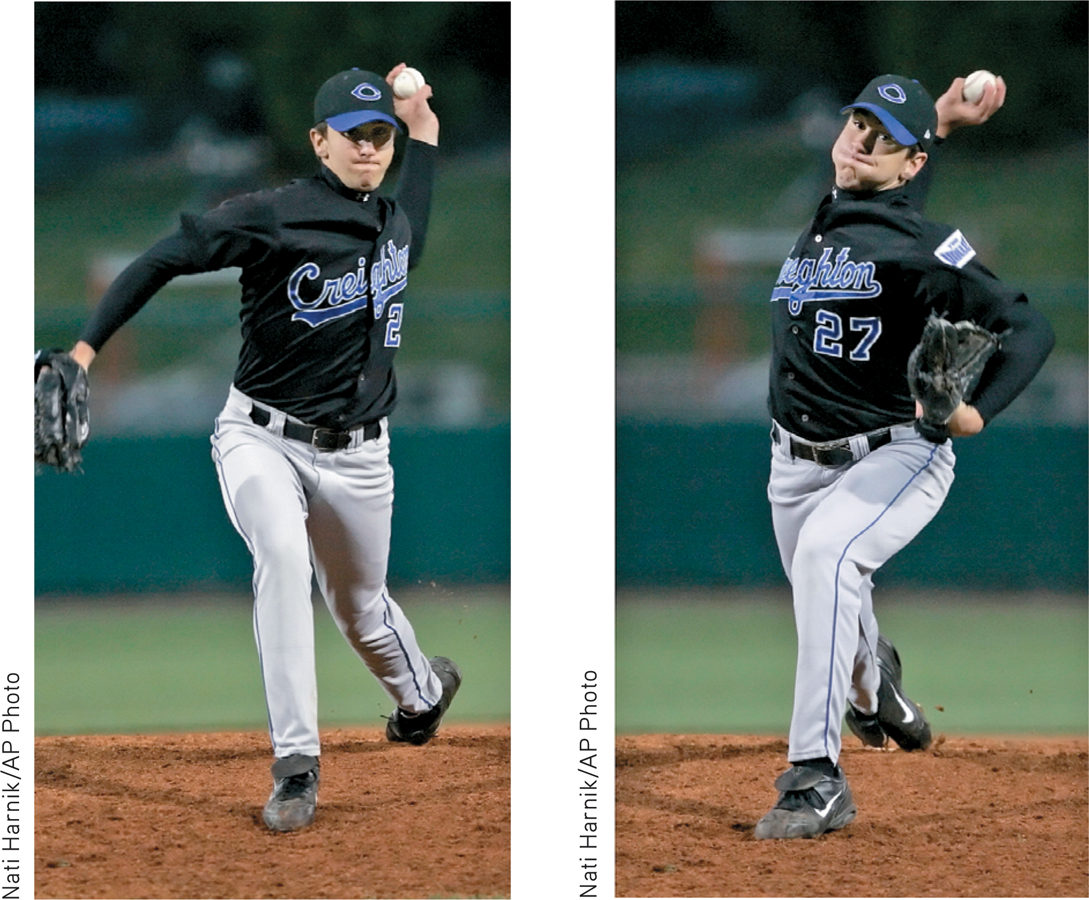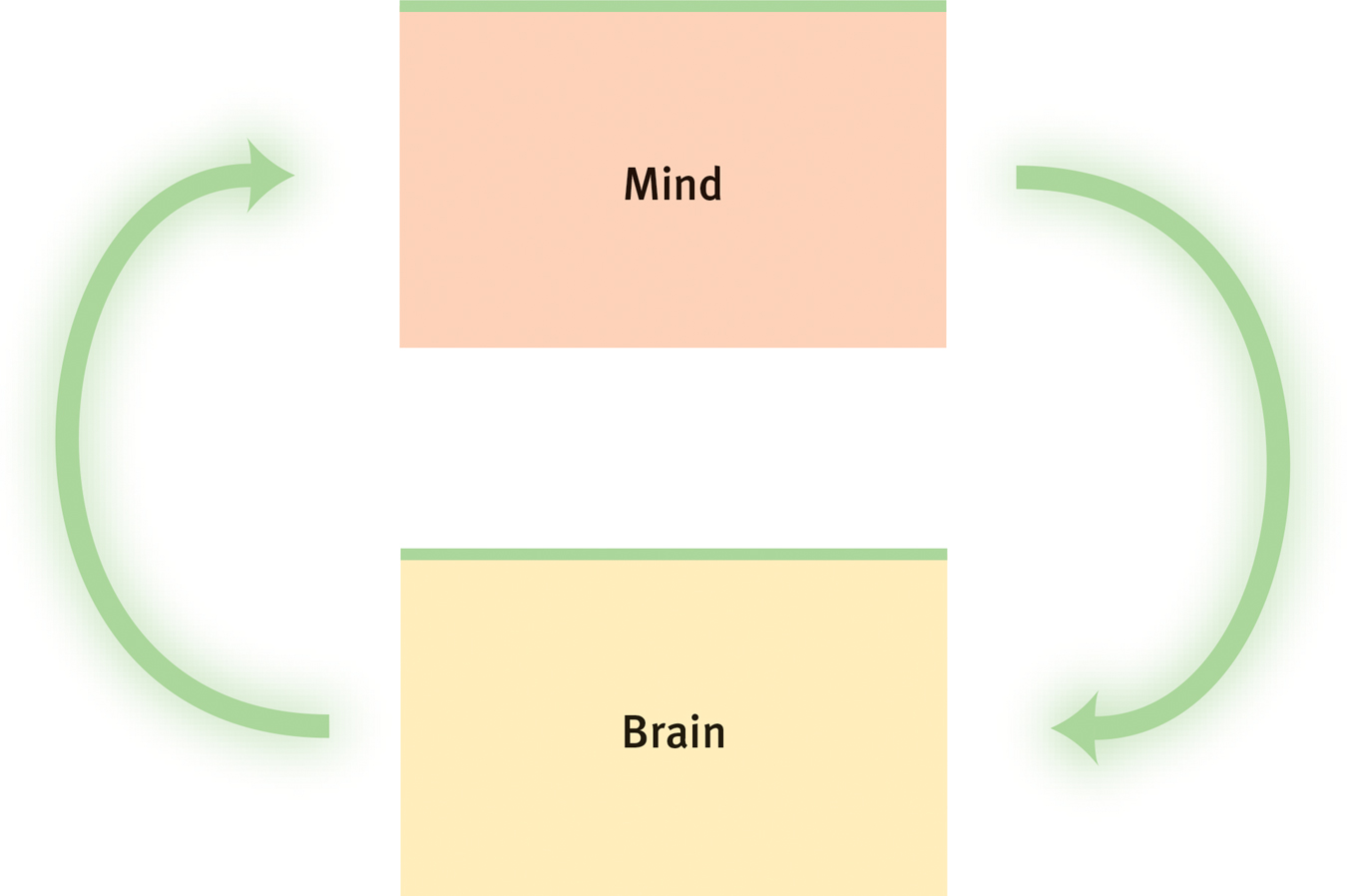7.2 Our Divided Brain
7-
Our brain’s look-
Splitting the Brain
In 1961, Los Angeles neurosurgeons Philip Vogel and Joseph Bogen speculated that major epileptic seizures were caused by an amplification of abnormal brain activity bouncing back and forth between the two cerebral hemispheres, which work together as a whole system. If so, they wondered, could they put an end to this biological tennis match by severing the corpus callosum, the wide band of axon fibers connecting the two hemispheres and carrying messages between them (see FIGURE 7.10)? Vogel and Bogen knew that psychologists Roger Sperry, Ronald Myers, and Michael Gazzaniga had divided cats’ and monkeys’ brains in this manner, with no serious ill effects.

 Figure 7.10
Figure 7.10The corpus callosum This large band of neural fibers connects the two brain hemispheres. To photograph the half brain at left, a surgeon separated the hemispheres by cutting through the corpus callosum and lower brain regions. The high-
So the surgeons operated. The result? The seizures all but disappeared. The patients with these split brains were surprisingly normal, their personality and intellect hardly affected. Waking from surgery, one even joked that he had a “splitting headache” (Gazzaniga, 1967). By sharing their experiences, these patients have greatly expanded our understanding of interactions between the intact brain’s two hemispheres.
To appreciate these findings, we need to focus for a minute on the peculiar nature of our visual wiring, illustrated in FIGURE 7.11. Note that each eye receives sensory information from the entire visual field. But in each eye, information from the left half of your field of vision goes to your right hemisphere, and information from the right half of your visual field goes to your left hemisphere, which usually controls speech. Data received by either hemisphere are quickly transmitted to the other across the corpus callosum. In a person with a severed corpus callosum, this information-

 Figure 7.11
Figure 7.11The information highway from eye to brain
Knowing these facts, Sperry and Gazzaniga could send information to a patient’s left or right hemisphere. As the person stared at a spot, they flashed a stimulus to its right or left. They could do this with you, too, but in your intact brain, the hemisphere receiving the information would instantly pass the news to the other side. Because the split-
In an early experiment, Gazzaniga (1967) asked these people to stare at a dot as he flashed HE·ART on a screen (FIGURE 7.12). Thus, HE appeared in their left visual field (which transmits to the right hemisphere) and ART in the right field (which transmits to the left hemisphere). When he then asked them to say what they had seen, the patients reported that they had seen ART. But when asked to point to the word they had seen, they were startled when their left hand (controlled by the right hemisphere) pointed to HE. Given an opportunity to express itself, each hemisphere indicated what it had seen. The right hemisphere (controlling the left hand) intuitively knew what it could not verbally report.

 Figure 7.12
Figure 7.12One skull, two minds When an experimenter flashes the word HEART across the visual field, a woman with a split brain verbally reports seeing the portion of the word transmitted to her left hemisphere. However, if asked to indicate with her left hand what she saw, she points to the portion of the word transmitted to her right hemisphere. (From Gazzaniga, 1983.)
When a picture of a spoon was flashed to their right hemisphere, the patients could not say what they had viewed. But when asked to identify what they had viewed by feeling an assortment of hidden objects with their left hand, they readily selected the spoon. If the experimenter said, “Correct!” the patient might reply, “What? Correct? How could I possibly pick out the correct object when I don’t know what I saw?” It is, of course, the left hemisphere doing the talking here, bewildered by what the nonverbal right hemisphere knows.
“Do not let your left hand know what your right hand is doing.”
Matthew 6:3
A few people who have had split-

 Figure 7.13
Figure 7.13Try this! People who have had split-
When the “two minds” are at odds, the left hemisphere does mental gymnastics to rationalize reactions it does not understand. If a patient follows an order (“Walk”) sent to the right hemisphere, a strange thing happens. The unaware left hemisphere doesn’t know why the patient begins walking. If asked, the patient doesn’t reply, “I don’t know.” Instead, the left hemisphere improvises—

 HOW WOULD YOU KNOW?Have you ever been asked if you are “left-
HOW WOULD YOU KNOW?Have you ever been asked if you are “left-
RETRIEVAL PRACTICE
- (1) If we flash a red light to the right hemisphere of a person with a split brain, and flash a green light to the left hemisphere, will each observe its own color? (2) Will the person be aware that the colors differ? (3) What will the person verbally report seeing?
1. yes, 2. no, 3. green
Right–Left Differences in the Intact Brain
So, what about the 99.99+ percent of us with undivided brains? Does each of our hemispheres also perform distinct functions? Several different types of studies indicate they do. When a person performs a perceptual task, for example, brain waves, bloodflow, and glucose consumption reveal increased activity in the right hemisphere. When the person speaks or calculates, activity usually increases in the left hemisphere.
A dramatic demonstration of hemispheric specialization happens before some types of brain surgery. To locate the patient’s language centers, the surgeon injects a sedative into the neck artery feeding blood to the left hemisphere, which usually controls speech. Before the injection, the patient is lying down, arms in the air, chatting with the doctor. Can you predict what probably happens when the drug puts the left hemisphere to sleep? Within seconds, the person’s right arm falls limp. If the left hemisphere is controlling language, the patient will be speechless until the drug wears off. If the drug is injected into the artery to the right hemisphere, the left arm will fall limp, but the person will still be able to speak.
To the brain, language is language, whether spoken or signed. Just as hearing people usually use the left hemisphere to process spoken language, deaf people use the left hemisphere to process sign language (Corina et al., 1992; Hickok et al., 2001). Thus, a left hemisphere stroke disrupts a deaf person’s signing, much as it would disrupt a hearing person’s speaking (Corina, 1998).
Although the left hemisphere is adept at making quick, literal interpretations of language, the right hemisphere
- excels in making inferences (Beeman & Chiarello, 1998; Bowden & Beeman, 1998; Mason & Just, 2004). Primed with the flashed word foot, the left hemisphere will be especially quick to recognize the closely associated word heel. But if given an insight-like problem—“What word goes with boot, summer, and ground?”—the right hemisphere more quickly recognizes the solution: camp. As one patient explained after a right hemisphere stroke, “I understand words, but I’m missing the subtleties.” The right side of the brain is also better than the left at copying drawings, recognizing faces, noticing differences, perceiving emotion, and expressing emotion through the more expressive left side of the face. Right hemisphere damage can greatly disrupt these abilities.
- helps us modulate our speech to make meaning clear—as when we ask “What’s that in the road ahead?” instead of “What’s that in the road, a head?” (Heller, 1990).
- helps orchestrate our self-awareness. People who suffer partial paralysis will sometimes obstinately deny their impairment—strangely claiming they can move a paralyzed limb—if the damage is to the right hemisphere (Berti et al., 2005).
Simply looking at the two hemispheres, so alike to the naked eye, who would suppose they contribute uniquely to the harmony of the whole? Yet a variety of observations—
 For a helpful animated review of this research, see LaunchPad’s PsychSim 6: Hemispheric Specialization.
For a helpful animated review of this research, see LaunchPad’s PsychSim 6: Hemispheric Specialization.
THINKING CRITICALLY ABOUT
THINKING CRITICALLY ABOUT: Handedness
7-4 What does research tell us about being left-handed? Is it advantageous to be right-handed?
Nearly 90 percent of us are primarily right-
Is Handedness Inherited?
Judging from prehistoric human cave drawings, tools, and hand and arm bones, this veer to the right occurred long ago (Corballis, 1989; MacNeilage et al., 2009). Right-
So, Is It All Right to Be Left-
Judging by our everyday conversation, left-
Left-

RETRIEVAL PRACTICE
- Almost all right-handers process speech in the __________ hemisphere; most left-handers process speech in the _____________ hemisphere.
left; left—
***
We have glimpsed an overriding principle: Everything psychological is simultaneously biological. We have focused on how our thoughts, feelings, and actions arise from our specialized yet integrated brain. Elsewhere in this text, we further explore the significance of the biological revolution in psychology.
From nineteenth-
Much as gas and air can give rise to something different—
“All psychological phenomena are caused by the brain, but many are better understood at the level of the mind.”
Tweet from psychologist Steven Pinker, June 10, 2013
Cells cannot be fully explained by the actions of atoms, nor minds by the activity of cells. Psychology is rooted in biology, which is rooted in chemistry, which is rooted in physics. Yet psychology is more than applied physics. As Jerome Kagan (1998) reminded us, the meaning of the Gettysburg Address is not reducible to neural activity. Sexual love is more than blood flooding to the genitals. Morality and responsibility become possible when we understand the mind as a “holistic system,” said Sperry (1992) (FIGURE 7.14). We are not mere jabbering robots. Brains make thoughts. And thoughts change brains.

 Figure 7.14
Figure 7.14Mind and brain as holistic system In Roger Sperry’s view, the brain creates and controls the emergent mind, which in turn influences the brain. (Think vividly about biting into a lemon and you may salivate.)
“‘Was the cause psychological or biological?’ is the wrong question when assigning responsibility for an action. All psychological states are also biological ones.”
Psychologists John Monterosso and Barry Schwartz, “Did Your Brain Make You Do It?” 2012
The mind seeking to understand the brain—